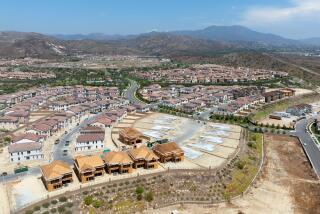1 Big, 1 Small, Both Deliver the Goods--Affordable Water
In the obscure world of water delivery in Orange County, the Irvine Ranch Water District and the Santa Ana Heights Water Co. represent the Cadillac and Rambler of the industry.
The product of a $141-million annual budget, the Irvine district is encased in an $8-million modern, glass and concrete structure that only recently sprouted from the area’s fertile farm fields. A corps of 215 employees maintain miles of pipeline that serve 150,000 South County residents.
Then there is Santa Ana Heights.
Headquartered in a low-slung house just off Bristol Street in Santa Ana, the company sign out front looks more like a marker for a roadside antique shop.
The friendly office staff sometimes double as meter-readers and its replacement parts are stored in the shade of giant fir trees in the back yard. It is a company that has survived since the 1920s even though its five directors hardly ever meet.
“We just got a new board member last month,” said company president C. Orville Reinhardt, “but I can’t remember his name.”
Irvine and Santa Ana Heights represent both ends of a complex water network that now is the focus of reform efforts, most involving the possible elimination of smaller districts through consolidation. But bigger is not necessarily better, because while opposite in style and method, Irvine and Santa Ana Heights deliver the same value for their customers: cheap water rates.
Formed 32 years ago as an agency of the state, the Irvine district has grown dramatically as the area was transformed from ranchland to housing tracts. Over time, the district has swelled to include the city of Irvine and portions of Tustin, Santa Ana, Newport Beach, Orange and Laguna Beach.
Although its service area has increased rapidly, monthly water bills--which average about $10.46 per household, according to a countywide survey--are kept relatively low.
Peer A. Swan, president of the district board, said the agency’s authority to levy property taxes on its residents continues to pay for its expansion costs. Efforts have also been made to decrease the district’s reliance on more expensive imported water and by keeping the size of its work force somewhat in check.
Inside the small house on Bristol Street, meanwhile, Reinhardt said Santa Ana Heights customers are getting the treatment afforded by a “mom-and-pop kind of business.”
Created decades ago to exclusively serve a subdivision now within the flight path of John Wayne Airport, the small company provides water to about 3,000 customers. Access to the water is restricted to landowners in the system, all of whom are “shareholders” in the company.
The stock can be neither bought nor sold, but is essentially a landowner’s ticket to tap into the company lines.
The company’s pipelines, which stretch from 23rd Street in Costa Mesa on the south to Santa Ana’s Bristol Street on the north, have been paid for long ago and no substantial renovations have been made in recent years, so customers are also getting cheap water.
According to the rate survey conducted by the Municipal Water District of Orange County, the average family’s monthly water bill amounts to slightly more than $16, even though the company’s entire supply comes from more expensive imported water.
Three people make up the company’s office staff, while all of the pipeline maintenance is contracted out to the larger Mesa Consolidated Water District. Mesa also does the company’s meter reading.
More to Read
Sign up for Essential California
The most important California stories and recommendations in your inbox every morning.
You may occasionally receive promotional content from the Los Angeles Times.










